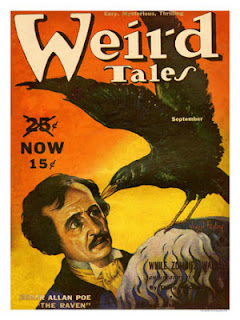AMERICAN GOTHIC:
an Englishman's View
The Munsters was an American television sitcom depicting
the home life of a family of benign monsters. It stared Fred Gwynne as
Herman Munster and Yvonne De Carlo as his wife, Lily Munster. The
series was a satire of both traditional monster movies and the
wholesome family fare of the era
The Addamses were a satirical inversion of the ideal American family; an eccentric,
wealthy clan who delight in the macabre and are unaware that people find them
bizarre or frightening. They originally appeared as an unrelated group of 150
single panel cartoons, about half of which were originally published in The New
Yorker between 1938 and creator Charles Addams's 1988 death.
The cartoons were little known in the UK. You might be lucky to come across
them on occassion amongst the well thumbed magazines at your local barber shop.
 |
| The young scientist at the centre of this extraordinarily early photo of an American museum has been identified as Edgar Allan Poe. |
Poe and his works influenced literature in the United States and around the world
Sleepy Hollow
Sleepy Hollow is a 1999 American horror film directed by Tim Burton. It is a film adaptation loosely inspired by the 1820 short story "The Legend of Sleepy Hollow" by Washington Irving and stars Johnny Depp and Christina Ricci
"The Legend of Sleepy Hollow" is a short story by Washington Irving contained in his collection The Sketch Book of Geoffrey Crayon, Gent., written while he was living in Birmingham, England, and first published in 1820. With Irving's companion piece "Rip Van Winkle", "The Legend of Sleepy Hollow" is among the earliest examples of American fiction still read today.
 |
| Ichabod Crane goes in search of the headless horseman |
EDWARD GOREY
Edward St. John Gorey (1925 – 2000) was an American
writer and artist noted for his playfully macabre illustrated books
In response to being called gothic, Gorey stated, "If you're doing nonsense it has to be rather awful, because there'd be no point. I'm trying to think if there's sunny nonsense. Sunny, funny nonsense for children — oh, how boring, boring, boring. As Schubert said, there is no happy music. And that's true, there really isn't. And there's probably no happy nonsense, either."
oooooooooooooooooooooooooooooooooooooooooooooooooooooo
 |
| Edward St. John Gorey (1925 – 2000) |
 |
| Cover art-work by Edward Gorey |
oooooooooooooooooooooooooooooooooooooooooooooooooooooo


































